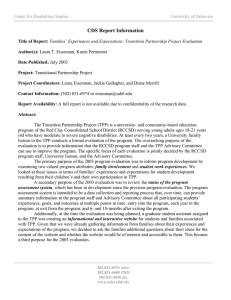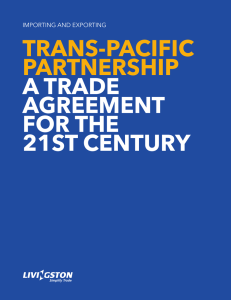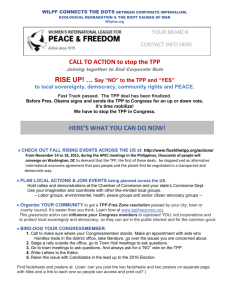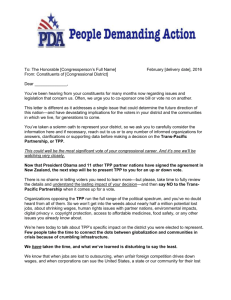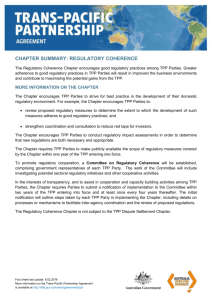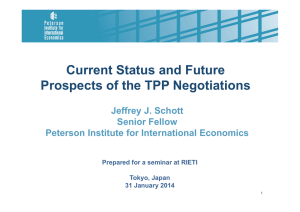Peter A. PETRI February 17, 2014
advertisement
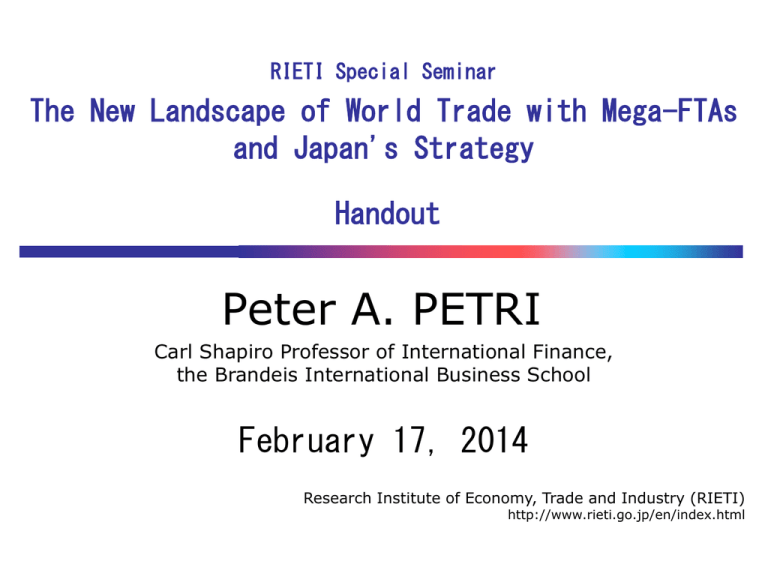
RIETI Special Seminar The New Landscape of World Trade with Mega-FTAs and Japan's Strategy Handout Peter A. PETRI Carl Shapiro Professor of International Finance, the Brandeis International Business School February 17, 2014 Research Institute of Economy, Trade and Industry (RIETI) http://www.rieti.go.jp/en/index.html The new landscape of world trade: the TPP and other mega‐regionals Peter A. Petri Brandeis University Research Institute of Economy, Trade and Industry February 2014 I. The TPP and world trade 2 I. The new landscape of trade 3 The mega‐regional trade negotiations 77% world GDP RCEP 26% TPP 38% TTIP 44% Slide 4 Why does the TPP matter? • The TPP is the most advanced of negotiations to create new rules for trade and investment • Trade agreements are dynamic; if successful, they draw in new countries • It will take decades to complete a new framework, but the world economy will benefit already in anticipation • Depending on configuration, there may be big winners and losers 5 Trade matters World trade as a share of world GDP 1st golden age 2nd golden age Source: Estevadeordal, Frantz and Taylor (2003) 6 Optimistic projections 2009 2013 2014 2015 2016 TPP RCEP TTIP Korea‐China . . . why not WTO too? 7 II. The TPP negotiations 9 Contest for 21st century template • New issues – supply chains – internet – rise of emerging markets, esp. China • Who will benefit? – advanced countries: services, IPR, investment – emerging countries: manufacturing, technology • Addressing the world “behind the border” – regulations, product and safety standards, customs procedures, IPR, investment rules, labor, environment 10 Points of contention Area Provisions Intellectual property More protection, access to national health systems Agriculture Tariffs on sensitive products (rice, dairy, sugar) Investment Reduce restrictions on FDI, ISDS Services Improved access in many services Government procurement “Buy national” policies, including at local level Rules of origin “Yarn forward” rules that benefit garments Electronic commerce No taxes and restrictions on data transfer Tariffs Eliminate most tariffs, reduce peaks State‐owned enterprises Level playing field for SOEs Labor ILO Declaration of Rights, including right to organize Environment International environmental treaties 11 Modeling the effects It’s difficult, uncertain, and subject to error! • Joint project with Michael Plummer, Fan Zhai • Novel Computable General Equilibrium Model (CGE) with 24 regions, 18 sectors • Start with 2010‐2025 baseline projection • Shock model by removing barriers (tariffs, non‐tariff measures, investment barriers) 12 Income gains for big countries, 2025($b) Japan United States China World TPP12 105 77 ‐35 223 TPP16 129 108 ‐82 451 RCEP 96 ‐0 250 644 228 295 700 2,280 FTAAPX 13 Potential income and export effects (%) 28% 14 Output changes: countries and sectors p or t Tra P ri v at ra n s Co de , T U ti ns t M is l it ie s ru c an t io n , Co ct u uf a Eq T ra cM Ma n sp ort ry ne E le ch i mm . eS erv Go ic e v 't s Se res . u ip . u ip ca l Me ctr i ic a ta l s ls Eq oo Ch em rel Ap pa es ,F ve r Te x ti l Be Fo od, ls M in era tw e s age eO t he r l tu r Ag r i cu t ea Wh e R ic Australia Brunei Canada Chile Japan Malaysia Mexico New Zealand Peru Singapore United States Vietnam ar (change in value added with TPP12, %) 3 0 1 2 ‐5 1 0 0 1 2 3 7 0 0 0 2 ‐40 0 7 ‐4 ‐5 0 0 0 2 0 3 2 ‐6 1 0 3 0 2 1 4 0 1 0 ‐1 ‐2 ‐2 2 ‐1 2 0 ‐1 ‐7 2 ‐2 1 1 1 ‐2 0 4 1 2 1 ‐1 ‐2 25 ‐3 5 12 18 ‐9 ‐1 1 7 ‐6 49 0 10 ‐10 ‐4 ‐5 42 ‐17 ‐2 1 ‐2 ‐12 62 ‐2 0 1 ‐2 2 2 0 ‐2 6 4 ‐1 0 1 0 1 1 2 4 1 2 1 0 ‐1 ‐7 ‐2 ‐3 2 ‐1 0 23 0 ‐3 ‐6 9 2 18 ‐3 0 1 7 4 23 3 4 ‐7 3 ‐2 20 ‐12 0 ‐9 0 ‐2 2 2 12 14 ‐1 ‐9 10 1 ‐1 ‐23 0 ‐18 ‐10 ‐3 0 ‐3 ‐1 ‐5 15 0 0 0 2 2 4 0 1 1 2 0 14 1 0 0 1 2 7 2 2 1 3 1 21 1 0 0 0 1 3 1 1 2 0 1 4 0 ‐1 0 ‐1 0 ‐9 ‐2 1 1 ‐1 1 ‐10 0 0 0 0 2 4 ‐1 1 0 2 0 7 15 Sources of economic gains • Higher productivity – Inter-sectoral shifts to more productive sectors – Intra-sectoral shifts to more productive firms – Higher real wages • More variety – More choice for consumers and producers • Increased international investment – Fewer restrictions > better technologies/management 16 How the TPP might grow RCEP 16 Cambodia China Hong Kong India Laos Myanmar Australia Brunei Japan Malaysia New Zealand Singapore Vietnam Indonesia Korea Philippines Thailand Canada Chile Mexico Peru United States TPP 12 TPP 16 17 And China? Officially… • China has become neutral toward TPP • US interest is focused on Investment Treaty Unofficially… • Possibilities for very large gains—and difficult adjustments • Framework for resolving tensions • What would it take to make it work? 18 Where are we heading? • Rival templates? TPP RCEP • Pathway? 4 … FTAAP 12 Korea, ASEAN, China, Others • Consolidation? TPP China – US FTAAP RCEP 19 III. The politics 20 The status • US administration – President listed trade as priority in State of the Union – USTR pushing hard on conclusion • Trade Promotion Authority – – – – Bipartisan bill is before the Senate Finance Committee Republican leadership has indicated support Democratic leadership has declined support Lots of activity, uncertainty… • Timing – Before President’s trip in April? – After the election in November? 21 US public: conflicted internationalism Should US just mind its own business? Is US involvement in global economy good? Disagree Agree Good Don't know Bad Pew Research, America’s Place in the World 2013 22 Do Free Trade Agreements help? FTAs have helped US FTAs have hurt US 53% 46% 45% 39% 35% 28% 32% 30% 22% 17% Oct 1999* Dec 1999* Mar 2007* Sept 2010* * Hart-McInturff for NBC NEWS/The Wall Street Journal Jan 2014 23 What’s wrong with the TPP? • • • • • • Negative impact on jobs? Negative impact on wages? Worse environment? Unsafe food? Helps large corporations? Helps small businesses? 52% vs. 30% 56% vs. 21% 48% vs. 18% 63% vs. 18% 72% vs. 12% 24% vs. 64% Hart Research/Chesapeake Consulting, January 2014. 24 What’s going on? • Puzzles – Active ideological opposition – Feeds into popular pessimism, anxiety, uncertainty • Explanation 1: Bad timing – Great Recession – Technological trends – Era of large deficits • Explanation 2: Political dysfunction – Decline of authority – The lobbyist – activist industry – Internet “echo chambers” 25 More information The Trans‐Pacific Partnership and Asia‐Pacific Integration: A Quantitative Assessment Policy Analyses in International Economics 98 by Peter A. Petri , Michael G. Plummer and Fan Zhai Peterson Institute of International Economics, November 2012 Understanding the Trans‐Pacific Partnership Policy Analyses in International Economics 99 by Jeffrey J. Schott, Barbara Kotschwar and Julia Muir Peterson Institute of International Economics, January 2013 The Trans‐Pacific Partnership: A Quest for a Twenty‐first Century Trade Agreement Edited by C. L. Lim, Deborah Kay Elms and Patrick Low Cambridge University Press, September 2012 Australian government website on TPP: http://www.dfat.gov.au/fta/tpp/index.html US government trade barriers survey for country/sector issues: http://www.ustr.gov/about‐us/press‐office/reports‐and‐publications/2013/NTE‐FTB 26 www.asiapacifictrade.org Slide 27
